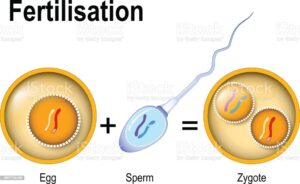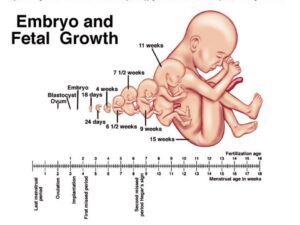Fetus Developmental Stages from Conception to Birth:
Fetus Developmental Stages from Conception to Birth: The pregnancy journey is an extraordinary and awe-inspiring process, marked by the incredible development of the fetus within the mother’s womb. From conception to the miraculous moment of birth, the fetus undergoes intricate and complex transformations. Understanding the stages of fetal development deepens our appreciation for the miracle of life and provides valuable insights into the delicate processes shaping our children’s future. In this article, we will explore the remarkable journey of fetal development, shedding light on the key milestones and providing a comprehensive understanding of the incredible growth within the womb.
I. The Early Stages: From Conception to Embryo Formation
Fertilization and the formation of the zygote;

The term “zygote” refers to the initial stage of development after the fusion of an egg cell (ovum) and a sperm cell during fertilization. It is a single-celled organism formed by the combination of the genetic material from both parents. The zygote contains the complete set of chromosomes, half from the mother and half from the father, and carries the genetic information necessary for the development of a new individual.
After fertilization, the zygote undergoes rapid cell division through a process called cleavage, forming a cluster of cells known as the blastocyst. The blastocyst then implants into the uterine wall, initiating further development and eventually giving rise to the embryo. The zygote stage marks the beginning of prenatal development and is the point at which the unique genetic characteristics of the individual start to take shape.
-
Cleavage and the formation of the blastocyst
-
Implantation into the uterine wall
-
Development of the embryonic layers (ectoderm, mesoderm, and endoderm)
-
Formation of the amniotic sac and placenta
II. The First Trimester: Rapid Growth and Organ Formation

-
Development of vital organs and systems (nervous system, heart, limbs, digestive system)
-
Formation of facial features and sensory organs (eyes, ears, nose, and mouth)
-
The emergence of the skeletal structure and musculature
-
Initiation of blood circulation and the development of the umbilical cord
Gender Determination and sexual organ development
III. The Second Trimester: Refinement and Maturation
-
Rapid growth and strengthening of the musculoskeletal system
-
Maturation of the nervous system and brain development
-
Formation of fingerprints and toeprints
-
Development of lanugo (fine hair) and vernix caseosa (protective skin coating)
-
Initiation of fetal movements and the ability to hear sounds
IV. The Third Trimester: Final Preparations for Birth
-
Continued growth and maturation of organs and systems
-
Accumulation of subcutaneous fat for insulation and energy storage
-
Improvement of lung function and the practice of breathing movements
-
Positioning for birth (head-down position in preparation for delivery)
Both the nervous and cardiac systems undergo significant development during fetal developmental stages. The nervous system is one of the earliest systems to begin forming, even before the cardiac system.
The development of the nervous system starts with the formation of the neural tube, which eventually develops into the brain and spinal cord. The neural tube forms from the ectoderm, one of the embryo’s primary germ layers. The process begins around three to four weeks after fertilization when the ectoderm thickens and forms a groove. This groove then closes and forms the neural tube. The neural tube differentiates into various regions, eventually leading to different parts of the brain and spinal cord. The development of the nervous system continues throughout the entire prenatal period, with the brain and nervous system maturing and becoming more complex.
On the other hand, the cardiac system begins its development slightly later than the nervous system. Around three weeks after fertilization, the heart starts forming as a simple tube-like structure. This tube then undergoes looping and further differentiation, leading to the development of the four chambers of the heart and the major blood vessels. The formation of the heart is vital for the transportation of oxygen and nutrients to the growing fetus.
Although the nervous system starts developing before the cardiac system, it’s important to note that both systems are intricately linked and develop concurrently throughout the prenatal period. The nervous system controls and regulates the functions of the cardiac system, ensuring proper heart rate and rhythm.
These developmental stage processes are complex and influenced by various genetic and environmental factors. Advanced imaging technologies, such as ultrasound and MRI, provide valuable insights into the development of the nervous and cardiac systems in real time, allowing healthcare professionals to monitor the progress and detect any abnormalities. Additionally, genetic testing and diagnostic procedures can provide further information about the health and development of these systems.
It’s essential to consult with healthcare professionals, such as obstetricians and pediatricians, for detailed and specific information regarding the development of the nervous and cardiac systems during pregnancy.
Early Lung Development: During the early stages of pregnancy, around weeks 4 to 7, the respiratory system begins to form. The lung buds, which are tiny outgrowths from the embryonic foregut, develop and branch into the surrounding tissue.
Formation of Bronchial Tree: As the fetus grows, the lung buds divide further, forming the bronchial tree. The bronchial tree consists of the main bronchi, bronchioles, and alveoli, responsible for gas exchange.
Surfactant Production: Around weeks 24 to 28, the type II pneumocytes in the fetal lungs start producing surfactant, which helps reduce alveoli surface tension. Surfactant is crucial for proper lung function and the prevention of lung collapse.
Alveolar Development: The alveoli, which are tiny air sacs responsible for oxygen and carbon dioxide exchange, continue to develop and multiply throughout the third trimester. The network of blood vessels surrounding the alveoli also increases, facilitating gas exchange between the fetal blood and the placenta.
Preparation for Breathing: Toward the end of the third trimester, the fetal lungs undergo various structural changes to prepare for breathing air after birth. The lungs become more compliant, and the airways open up, allowing for improved airflow.
It’s important to note that the full maturation of the fetal lungs typically occurs around 36 to 37 weeks of gestation. However, babies born earlier may require medical interventions, such as artificial surfactant administration or respiratory support, to help with lung function until their lungs are fully developed.
Overall, the development of the fetal lungs is a dynamic and intricate process, with multiple stages and factors involved. Proper prenatal care, including avoiding smoking and maintaining a healthy lifestyle, can contribute to the optimal development of fetal lungs. Consultation with healthcare professionals is crucial for monitoring the progress of lung development during pregnancy.
The process of fetal development is an incredible testament to life’s marvel. It starts with a single cell and forms organs and systems, each stage shaping the fetus’s future. Knowing fetal growth gives insights into womb processes and stresses prenatal care. Understanding these changes lets us appreciate life’s intricacies, valuing the process that brings a new human into the world.
